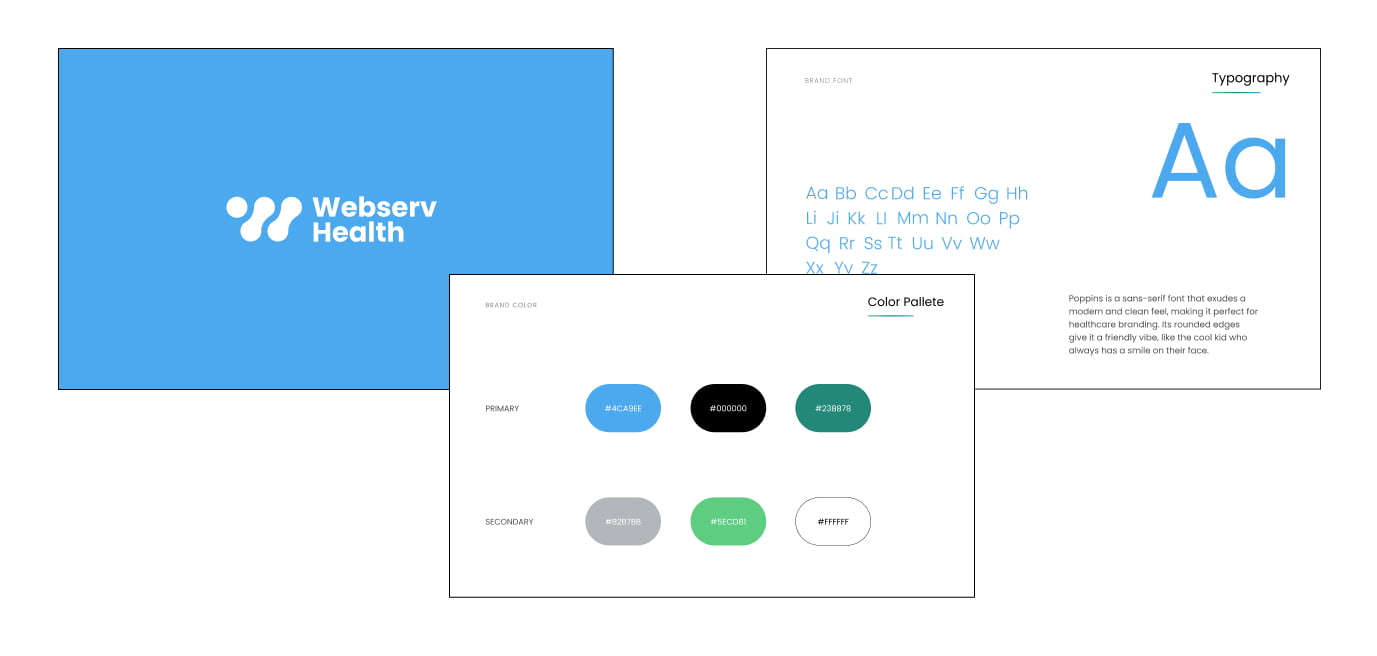
Welcome to the wonderful world of healthcare branding! Where every organization believes that a well-designed logo is key to world domination. Well, not quite. But strong healthcare brand identity is critical to building trust and establishing credibility in the industry.
If you’re wondering why you need a brand identity, consider it like this: your brand is your organization’s personality. And just like in real life, people are more likely to trust and connect with a personality that they can relate to and understand.
So, how do you create a brand identity that stands out in the crowded healthcare market? It’s not rocket science, but it does take a bit of creativity and strategic planning. In this blog post, we’ll cover everything from logo design to typography and website development. By the end, you’ll be well-equipped with the knowledge and tools to create a brand identity that truly represents your organization.
But first, let’s take a look at why brand identity matters in healthcare. Hint: it’s not just because a pretty logo looks nice on your website (although it does help). Keep reading to find out more.
Ah, the healthcare logo. It’s the face of your brand, the first thing people notice, and the key to world domination. Okay, maybe not the last one, but a strong healthcare logo is critical to building trust and establishing credibility in the industry.
Your healthcare logo is the cornerstone of your brand identity. It’s like the superhero outfit that helps people recognize your organization and everything it stands for. A strong logo can help you stand out in a crowded market, establish credibility and trust, and make a lasting impression in the minds of your audience.
There are a few key elements that every successful healthcare logo should have:
When designing your healthcare logo, there are a few best practices to keep in mind. Firstly, it’s important to understand your audience. Who are they? What are their values and preferences? What will appeal to them? Hint: if you’re a pediatric clinic, avoid designing a logo that looks like it belongs on the side of a hearse.
Next, research your competition. What do their logos look like? How can you create something that’s different and unique? You don’t want to be mistaken for another healthcare organization, especially if they’re a competitor.
Choosing the right colors and fonts is also key to a successful healthcare logo. Your colors should be consistent with your brand identity and evoke the right emotions in your audience. No one wants to see a bright red logo when they’re about to undergo surgery. And while we’re on the topic of fonts, please, for the love of all things good, avoid using Comic Sans.
Lastly, keep it simple. Complexity and clutter are the enemies of effective logo design. Remember, less is more.
By following these best practices, you’ll be well on your way to designing a healthcare logo that’s memorable, effective, and doesn’t look like it was designed in Microsoft Paint.
Your healthcare brand’s color palette and typography can make a big impact on how people perceive your organization. Here’s what you need to know about choosing the right colors and fonts for your brand.
Color plays a huge role in how people perceive and interact with your brand. Different colors can evoke different emotions and associations, and can even influence purchasing decisions. For example, blue is often associated with trust and reliability, which is why many healthcare organizations use it in their branding.
Check out Wordstream’s color psychology resource to learn the ins and outs of color theory and discover how to use color to evoke the right emotions and attract the right patients.
When choosing your healthcare brand’s color palette, there are a few things to keep in mind:
Your healthcare brand’s typography is also essential for creating a consistent and memorable visual identity. The right font can help you communicate your brand’s personality and values, and make your messaging more effective.
When choosing your healthcare brand’s typography, here are a few best practices to keep in mind:
Feast your eyes on our mock branding for the hypothetical healthcare organization of Webserv! We’ve included an image below that showcases our crisp logo, calming color palette, and legible typography.

Creating a healthcare brand identity that truly represents your organization and resonates with your patients can be a challenging task. That’s why Webserv is here to help. As a healthcare marketing agency, we have the experience and expertise to create a brand identity that elevates your organization’s profile and inspires trust and confidence in your patients.
You won’t have to worry about designing a logo that looks like it was made in the Stone Age. We’ll handle everything from start to finish, so you can focus on providing top-notch care to your patients. Visit how Branding and Positioning can create a memorable brand identity that reflects your values.
Your healthcare brand’s website is like the modern-day equivalent of a first date. If it’s awkward and unappealing, you can kiss any chance of a second date (or appointment) goodbye. But fear not! With a few tips and tricks, you can create a website that charms your audience and makes them want to come back for more.
UX design is all about making your website easy and enjoyable to use. Here are a few best practices for UX design in healthcare websites:
At Webserv, we specialize in providing professional website design and development services that are specifically tailored to the unique needs of healthcare organizations. Whether you need a new website or want to improve your existing one, we have the expertise and experience to create a website that is engaging, visually appealing, and optimized for maximum performance.
When it comes to designing your healthcare website, consistency, and visual appeal are key. Your website design should be consistent with your healthcare brand identity, using the same colors, typography, and tone as your other branding materials. This not only helps to strengthen your brand identity but also makes your website more recognizable and memorable to your audience.
When it comes to visuals, your website should incorporate images that are both visually appealing and representative of your healthcare brand identity. No one wants to see generic stock photos of people wearing lab coats and looking awkwardly staged. Instead, use images that reflect your brand’s personality and the experience you offer your patients. A picture is worth a thousand words, and in the world of healthcare, the right image can make all the difference.
Last but not least, your website should tell a story that emotionally resonates with your audience. A great website tells a story that speaks to its audience, inspiring trust and confidence in your brand. Storytelling helps to create an emotional connection with your audience, which can ultimately lead to higher patient loyalty and engagement.
Website development is the nerdy technical side of building a website, but it’s no less important than design. When developing your healthcare website, there are a few key things to keep in mind.
First, speed is crucial. Your website should load faster than a cheetah chasing its prey because slow-loading websites can lead to high bounce rates and lost opportunities. Additionally, your website should be secure, with up-to-date software and encryption to protect against cyber threats. Trust is paramount in healthcare, and a website that doesn’t look safe or secure can be a major turn-off for potential patients.
Finally, SEO is important for making sure your website appears high in search results. By using the right keywords, meta descriptions, and content that matches what your audience is searching for, you can make sure your website is visible to the right people. Remember, your website is your virtual storefront, and you want to make sure people can find it when they’re looking for the services you offer.
Healthcare Brand Identity refers to the visual and verbal representation of a healthcare organization. It includes the name, logo, color scheme, typography, messaging, and tone of the brand. A well-designed brand identity helps healthcare organizations establish a consistent and recognizable image that resonates with patients and builds trust.
Healthcare Brand Identity is crucial for building trust with patients and stakeholders. Patients need to know they can rely on a healthcare organization to provide high-quality care, and a well-designed brand identity helps to communicate this reliability. Additionally, a strong brand identity can differentiate a healthcare organization from competitors, helping to attract and retain patients.
Developing a Healthcare Brand Identity involves a strategic process of research, analysis, and design. This process typically begins with a brand audit, which involves reviewing the current brand identity and assessing its strengths and weaknesses. Then, a target audience analysis is conducted to identify the key characteristics and preferences of the patients and stakeholders that the brand is targeting. With this information, designers can create a visual and verbal identity that accurately reflects the healthcare organization’s values, personality, and goals.
Key elements of Healthcare Brand Identity include the logo, color scheme, typography, messaging, and tone. The logo should be simple and memorable, and the color scheme should reflect the personality and values of the brand. The typography should be legible and easy to read, and the messaging should be concise and clear. The tone should be empathetic and reassuring, reflecting the caring nature of the healthcare organization.
Maintaining a Healthcare Brand Identity involves ensuring that all communications and touchpoints with patients and stakeholders are consistent with the brand identity. This includes everything from advertising and marketing materials to patient forms and staff uniforms. A brand style guide can be developed to help maintain consistency, outlining the rules and guidelines for using the brand identity in various contexts. Regular brand audits can also help to ensure that the brand identity remains relevant and effective over time.
At Webserv, we understand the importance of strong branding when it comes to healthcare organizations. That’s why we offer comprehensive brand development services that are designed to help you stand out in a crowded marketplace. Our team of experts has the knowledge and experience to develop a brand identity that truly represents your healthcare organization’s unique values, personality, and goals.
From creating memorable logos and selecting the perfect color palette to craft compelling messaging and developing a cohesive marketing strategy, we have the expertise to take your brand to the next level. With Webserv’s brand development capabilities, you can establish a strong, distinctive brand identity that sets you apart from your competition and attracts more patients to your practice.